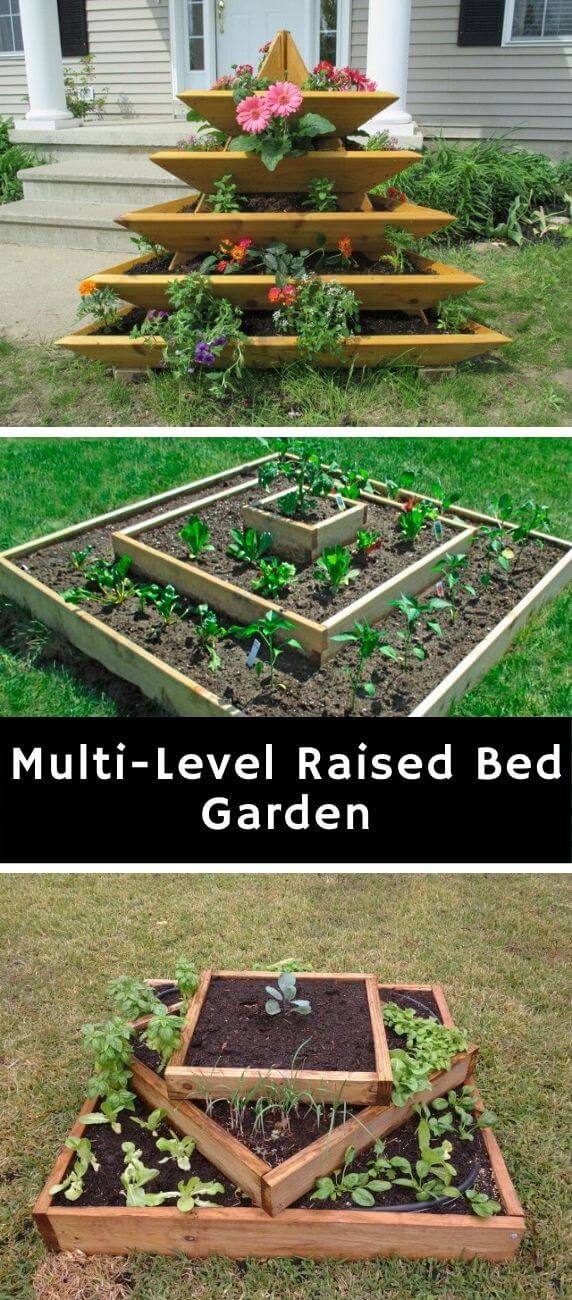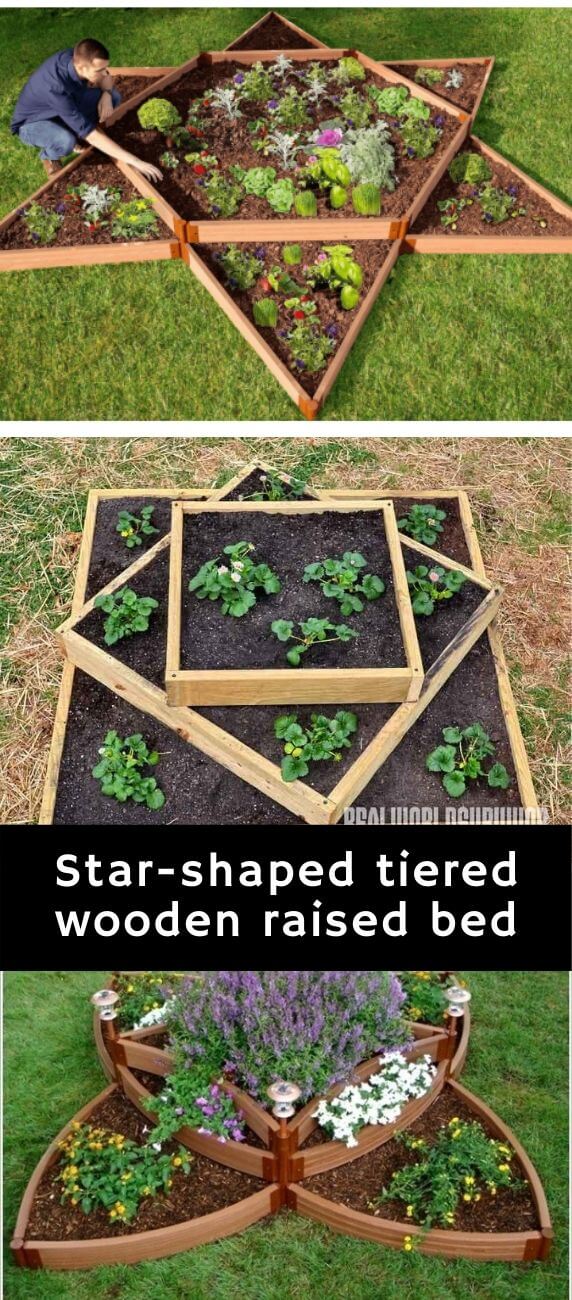The idea of having raised garden bed plans is very appropriate for urban gardeners with cramped up garden spaces.
This garden bed plan refers to elevated garden beds to keep critters out of reach and for water to be drained efficiently without accumulating at the pot’s bottom. Raised garden beds also have high aesthetic value and honestly, the designs for this know no bounds.
15 raised garden bed plans and ideas

How to Build a Raised Bed Garden Plot
Raised wood-framed garden plots offer a number of advantages for gardeners, including protection from animals, custom soil mixture, and an attractive look.
With just a few basic tools and easily acquired materials, anyone, no matter how (un)skilled, can construct a simple raised bed garden plot out of landscape timbers found at most home improvement or garden supply stores. Because it will lift the garden plot above ground, beyond the reach of many small herbivorous creatures, a raised wooden garden bed is a simple, functional, and attractive choice for gardeners in most urban environments.
This plan provides guidelines for building a raised wood-framed garden bed using either treated or untreated lumber. This design is for an 8’x4’ wooden raised garden bed. However, the construction principles are the same for a raised garden bed of any size. Only the list of materials and lengths would need to be altered.
You can hire a professional like Laguna Beach tree experts for gardening tips.
List of Materials for Constructing a Raised Garden Bed
- 12-8’ Landscape Timbers (rounded or square)
- 8-12” Galvanized Spikes
- 36-6” Galvanized Spikes (or 2” longer than the thickness of the landscape timbers)
- 1- 8’x4’ layer of corrugated cardboard
- 1-8’x4’ layer of Garden Mulch (wood chips, or other mulch material)
- 1-8’x4’ layer of Compost
- 1-8’x4’ layer of Topsoil
- Garden gloves
List of Tools Needed to Construct a Raised Garden Bed
- Powered Drill (NOT cordless)
- Large Hammer (two pound sledge)
- Large Drill Bit (slightly smaller diameter than the diameter of the 12” spikes)
- Small Drill Bit (slightly smaller diameter than the diameter of the small spikes)
- Large Saw (any saw that will cleanly cut through the landscape timbers)
Raised Garden Bed Assembly Instructions
- Cut four of the 8’ landscape timbers in half (creating 8-4’ sections)
- Measure the width of the landscape timbers.
- Multiply the width by 2 (if the timbers are 3” wide then 6” is the number used need for steps 4 & 5)
- Cut 2x the width of the timbers from 4 of the 4’ timbers (so if the timbers are 3” wide, cut 6” off of 4-4’ timbers)
- Cut 2x the width of the timbers from 4 of the 8’ timbers (so if the timbers are 3” wide, cut 6” off of 4-8’ timbers)
- Next find a good level spot for the garden bed and lay two 8’ timbers out and put two of the “short” 4’ timbers (with 2x the width removed) between the ends of the 8’ timbers.
- Make sure that all corners are square.
- Drill (fitted with a bit that is slightly narrower than the 12” galvanized spikes) holes at the 1/3 and 2/3 points along each of the timbers.
- Hammer 12” spikes through the holes and into the ground; keep all corners square. This layer should now be firmly anchored to the ground.
- Place a 4’ timber over each of the end pieces that have been anchored into the ground. These will lap over the ends of the bottom 8’ timbers.
- Between these (running the length of the bed) place two of the “short” 8’ timbers (with 2x the width cut off).
- Drill three holes (using the drill bit that is slightly narrower than the 6” galvanized spikes) in every corner (two on the “long” board at each corner, and one on the “short” board at each corner.
- Continue building the box in this fashion by overlapping long and short boards until there are four layers of timbers, each spiked to the layer below.
- Install a layer of corrugated cardboard/newsprint. Wet thoroughly.
- Add compost, topsoil, and garden mulch until the bed is full.
This proven method of construction is very adaptable. Gardeners should feel free to alter the dimensions and use whatever soil mixtures they deem necessary.
Stone Raised Beds/Raised Bed Borders
One thing about raised beds is that they could also function as pavement accents or stone borders. They are most commonly seen in Mediterranean or Hispanic house designs. These raised beds complement the stone patios and balconies of these types of houses.
You can make a stone raised bed border to emphasize your beautiful palms and other big plants like this one from Flikr. Make it as a pavement border or to even fence off your house if you want to.

You can also make tiered stone borders that will adorn your lawn and highlight prized plants. It is a good accent border to brick house designs too. One good example is this one from Den Garden.

But no pressure, you can keep it classy and old school where the succulents, herbs and veggies could thrive like in this one from Houzz Buzz.

Metal Raised Beds
The good thing about metal raised beds is that you could totally use scrap metal sheets without fear of rust. Aside from them being low-maintenance, they are also good in keeping the temperature for the plants regulated so it is more than just a planter really.
You could go full metal with this raised bed design and give an industrial rustic vibe to your garden like this one. You can pull this off with a few scrap metal and some welding jobs.

You can also toy on some leftover roofing materials like metal roof sheets and PVC pipes to make another industrial looking raised garden bed like this one from Instructables.

Or what about some wood and metal magic for your herbs and spices? That is possible and it is truly a beautiful raised bed like this one from Family Handyman.

Wooden Raised Beds
Wood designs never run out of style and it is the go-to design of anything garden, to be honest. The access to wood materials and to construct crafts from it is easy-peasy and it just gives off the right feels for the garden regardless if you want it to feel bohemian, classic barn style, rustic and country, you name it, wood raised beds got it.
You can start with making narrow, elongated raised beds that will be put in open elevated concrete spaces in the backyard for herbs and small plants like this one featured in the UMN Extension.

You can also make barn-style wooden raised beds to cluster your plants, succulents and herbs in one big raised bed for each category like this one from Good Housekeeping.

And lastly, you could make wooden tiered raised beds to do the same purpose as the individual clustered raised beds. Check this out from Harrod Horticultural.

Raised Bed Trellis
Not only will you make the raised beds more functional by adding trellises where the vine plants will climb, you are also giving your garden another layer of aesthetics with those trellised plants. This is like an extension of the wood ideas because the default material for this one would be wood and chicken wire.
You could go all out and over the top with wood and metal sheet arbor like this one from The Spruce to make harvesting easier and to put those vine plants into an organized look.

You can also make a cart type raised bed trellis for a more organized one-stop-shop herbarium like this one from Earth Easy.

Or if you want a more elaborate design on a stone raised garden bed with trellis, you can check this out from Gardening by Lorraine.

Tiered Raised Beds
Tiered raised beds are mostly done for flowers and succulents. Tiered raised beds make good centerpieces in the flower garden. Again, the most common material used for this type of design is wood but you can always improvise and be creative.
There are no bounds to how many tiers and what shape you want to go for in this design. Look at this pagoda-shaped tiered raised bed from Wayfair and front gate

Or what about a boat of flowers with two tiers highlighting a potpourri of blooms.

Lastly, you could diversify using any shape like this star-shaped tiered wooden raised bed from Real World Survivor.

Conclusion

Raised beds does not just mean elevated garden beds. They can be anything we want to be and more. They are functional and attractive at the same time and are easy to make as long as you have working ideas about how to go about it like these 15 ideas that we have here.





